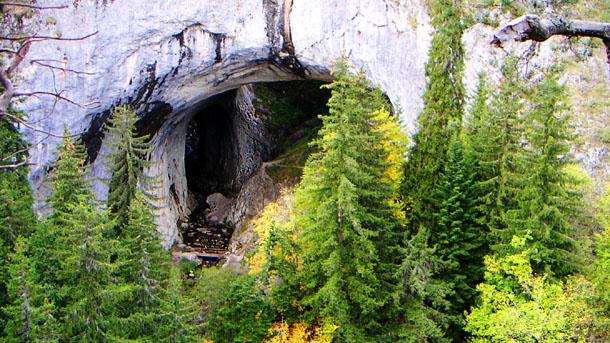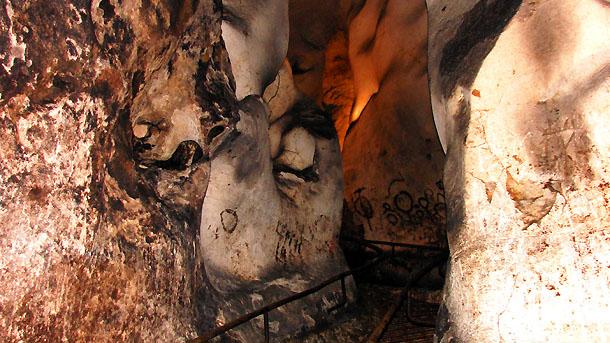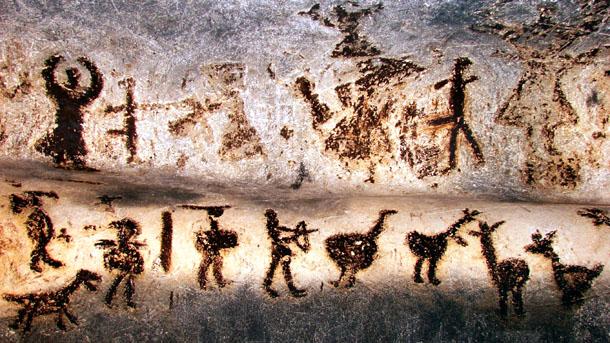
The numerous caves in Bulgaria are an attraction for speleologists and tourists, offering underground labyrinths and halls, cave rivers and limestone formations. The sanctuary caves in Bulgaria are ore than 90, an ethnological study shows. Some of them have been inhabited in pre-historic times, like the famous Magurata cave displaying valuable cave drawings along the walls. Others have served as astronomic observatories or sanctuaries and ritual sites of the ancient Thracian. In the Middle Ages Christian hermits creates temples and seclusion sells in the rocks like the popular Aladja Monastery or the still acting Besarbovski Monastery. In this edition of Folk Studio Rumyana Panayotova offers some popular legends for the less popular Bulgarian caves.

A fairy tale brings to our time the story about “Russin Kamak” cave /the Bulgarian for Russin Rock/, a dragon lived in the cave in times of old. Once he went down to Russokastro village to join the village dances taking the appearance of a man. One of the young girls, Russa, noticed the tale under his clothes and mocked him. Everyone around had a good laugh. The dragon got furious and caused a frightening whirlwind with so much dust in the air that no one could see a thing for quite some time. When the wind calmed down and the dust settled people saw that Russa had disappeared. They realized that the dragon in disguise had taken her away. The flying dragon hid the girl in the cave. Then he returned to the village to see how the people would react. He met Russa’s mother who had come out to look for her daughter. As he saw her, the dragon transformed into a dog and attacked her. The distressful mother ran away back to village. Time passed and one night the dragon returned to the village, looking for Russa’s mother. He needed her help as his Russa was having a baby in the cave. The old mother stayed with them to help bring up the child. The dragon then sent the old woman away as she was no longer needed, but upon seeing her off, he filled her apron with coal for her fireplace. She got angry and threw the coal away. However, when she got home she notices that one little piece of coal had stuck to her apron and had turned into a gold coin. The legend was told for many generations and the cave remained named after the girl.
There is a similar story about a cave named after another girl – Elena, in the Stranja Mountain, also in Southeast Bulgaria.
Yet another cave – Uhlovitsa, in the Rhodope Mountains, Southern Bulgaria was believed to be the dwelling of the Devil and his Lady-devil. When the moment came for the devil family to have their baby-devil, they called am old woman from the village to midwife the lady of the cave. The devils then again rewarded her amply with coals that turned into gold coins. The next song tells a similar story and is called “The dragon was talking to Rada”.

Perhaps the folk tales about the mysterious conception and childbirth in a cave were a later adaptation of an ancient cult. A few years ago archeologists discovered a cave testifying to the existence of that cult. The place had been an ancient Thracian sanctuary. Only once in the year – the day springtime solstice – a sunray penetrates into the cave throwing light to a depth of 22 meters. It is believed that the cave is an ancient Orphic altar as the place symbolizes the Mother-Goddess whom the Sun God fecundates in this single moment. This imagery is well supported by the form of the cave, which was called the Womb. There were pagan rituals in our lands that took young girls and boys to some cave to introduce the ritually to maturity. Furthermore, folk believes have it about certain caves, that if a childless woman spends the night there or drinks water from the magic spring in the cave, she would conceive. One such cave still exists in the Stranja Mountain. Later on this belief was Christianized and people believed that St, Marina, who lived in that cave not far from the sea, is the protector of women and helps them in childbirth. According to the Eastern Orthodox Church Christ was born in a cave. That is why in Orthodox icons the Holy Mother and Child are depicted in a cave.
English version: Iva Letnikova
The Philip Koutev National School of Folk Arts is not just any school - it is a talent laboratory. It is the first school not only in Bulgaria but in the Balkans for professional study of folklore. It is located in the heart of the beautiful town of..
Scientists from the Sorbonne will study the cultural heritage preserved in the Regional Ethnographic Open-Air Museum "Etar" , informs public broadcaster BNT. In March this year the French scientists together with experts of REOM "Etar" will study elements..
The day of St. Tryphon (1 February old style, 14 February new style) is celebrated by vine growers, falconers and gardeners in Bulgaria. Trifon Zarezan comes around with vine pruning and wine drinking St. Tryphon is believed to help..

+359 2 9336 661
